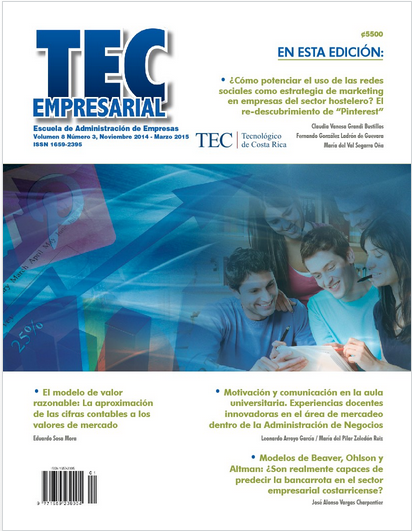Modelos de Beaver, Ohlson y Altman: ¿Son realmente capaces de predecir la bancarrota en el sector empresarial costarricense? (Models of Beaver, Ohlson and Altman: are really able to predict the bankruptcy in the Costa Rican business sector?)
Main Article Content
Abstract
El presente artículo analiza la aplicación de mo- delos para la prevención de bancarrotas empresariales en el sector empresarial costarricense. Se aplicaron los modelos a un grupo de empresas que se acogieron al proceso de intervención financiera, o quiebra, en el Juzgado Concursal de los Tribunales de Justicia de San José, con el fin de determinar si estos modelos fueron capaces de predecir la bancarrota. Dentro de los hallazgos principales están que el Modelo de
Altman calificó a cuatro de las cinco empresas anali- zadas como zona roja el año en que se declararon en quiebra, el Modelo de Ohlson, con su ecuación O1 u O3, calificó en quiebra las cinco empresas el año en que se dio, y el modelo de Beaver calificó como el año con peores indicadores al último en tres oca- siones, a diferencia de los otros modelos, los cuales no indicaron que el año de quiebra tuviera los peores indicadores.
Abstract
This article analyzes the models for company bankruptcy prevention used by the Costa Rican business sector. The author applied the studies models to the selected group of companies that had started the judicial intervention or bankruptcy process within the Bankruptcy Court of the Justice Court of San Jose. The objective was to determine if the selected models were capable to prevent the bankruptcy before it initialized. The primary fin- ding was an EM Score 4:5 analyzed companies in
the red zone that had filed for bankruptcy within that year. The use of the O1 and O3 equations of the Ohlson method was to predict the bankruptcy of the five companies in the year that had filed to have a bankruptcy case. However, in the Beaver method the companies scored a three as the worst indicators of the year to file for bankruptcy yet the remaining company’s worst year was not the ability to file for bankruptcy within the time.
Article Details
The digital version of the journal is registered under the BY-NC-ND 4.0 Creative Commons license. Therefore, this work may be copy and redistribute the material in any medium or format, as long as you give appropriate credit, provide a link to the license, and indicate if changes were made. You may do so in any reasonable manner, but not in any way that suggests the licensor endorses you or your use.
The authors keep the copyright and give the journal the right of the first publication and the possibility of editing, reproducing, distributing, exhibiting and communicating in the country and abroad through printed and electronic means. On the other hand, the author declares to assume the commitment on any litigation or claim related to the rights of intellectual property, exonerating of responsibility to the Business School of the Costa Rica Institute of Technology.


